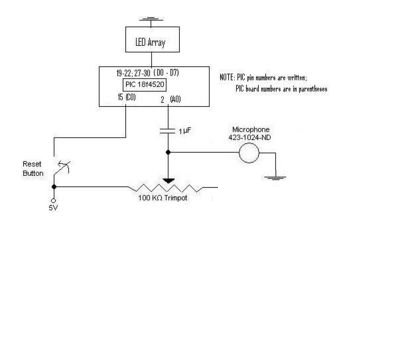Microphones
Original Assignment
This project is to demonstrate a "clapper" device using an electret microphone (e.g., the 423-1024-ND from digikey). Build an appropriate circuit and write a program to continuously display the volume of the sound it receives as a "light bar" on the PIC board LEDs.
Overview
A "clapper" device will be built using a PIC 18F4520 and an electret condenser microphone (in this case, the 423-1024-ND from digikey) as an analog input. The device operates on the principle that the microphone will convert the sound into an analog input to the PIC and as the sound increases in volume, the analog input's amplitude will increase. This input is then converted into an output on the set of LEDs soldered onto the PIC's circuit board. This output works as a light bar; it displays the minimum one LED for quiet sound levels and activates additional LEDs as the sound becomes louder -- up to a maximum of eight. The sensitivity of the microphone is adjustable through a gain potentiometer.
The most commonly used microphones for audio use capacitance charge (condenser microphones), electromagnetic generation (dynamic microphones), or piezoelectric generation. In a condenser microphone, a thin membrane of the microphone acts as one plate of a capacitor and a nearly constant charge is maintained on the capacitor. The voltage maintained across the capacitor plates changes with the vibrations in the air, according to the capacitance equation:
- where Q = charge in coulombs, C = capacitance in farads and V = potential difference in volts, resulting in an electrical signal. Electret microphones, a type of condenser microphone, replace the externally-applied charge with a permanently fixed-charged material. The electret is a stable dielectric material with a permanently-embedded static charge. Electret microphones require no polarizing voltage but, due to their integrated pre-amplifier, require a small amount of power either from microphone inputs as phantom power or from a small battery. Due to mass-production of these devices, electret microphones lack the precision needed for high-quality microphones.
Due to the variable nature of ambient noise, a calibration "reset" button was included that would reset the output LEDs based on the environment's baseline noise level. This calibration was done via software averaging of the ambient volume level. The device that is built currently follows the principles of the "clapper" device in that the higher the analog input is received, the more LEDs will be shown. However, due to the brevity of the audio input peak for shorter signals such as a clap, it is sometimes difficult to see the correspondingly brief output. A further step would be to install a software switch that would detect the characteristic sound pattern of a clap and activate a digital output upon recognition.
Of the three microphones tested (Electret Microphone, Sony F-V100, and a small dynamic microphone), the electret microphone showed the greatest sensitivity to varying noise levels.
Circuit
The circuit built for this example uses an electret microphone to listen to external sound and displays the volume level as a light bar on the PIC board LEDs. The microphone uses a single analog input pin of the PIC.
Optional features present in the shown circuit diagram include a potentiometer gain knob for adjusting the microphone's sensitivity and a calibration button for setting the baseline ambient noise level. The code governing the operation of the calibration button is included below; the button itself is wired into a digital input of the PIC. Refer to the photo and diagram for details.
Code
/*
microphone.c by JJ Darling, Alex Leung, Ben Schriesheim
This code will take an analog microphone input and display the power of the single
as an easily read LED array. One light on means the input matches the ambient noise,
and all eight lights on means the microphone is receiving a loud noise.
The reset button can be used to match the lowest output to the ambient noise.
This code was derived off of the analog input code written by Prof. Michael Peshkin, which
can be found in the source code repository on this wiki.
*/
#include <18f4520.h>
#DEVICE ADC=8 // set ADC to 8 bit accuracy.
#fuses HS,NOLVP,NOWDT,NOPROTECT
#use delay(clock=20000000)
signed int16 value;
int16 valueinit=0;
int k=0;
void initialize();
void main() {
setup_adc_ports(AN0); // Enable analog inputs AN0;
setup_adc(ADC_CLOCK_INTERNAL);
initialize();
while (TRUE) {
set_adc_channel(0); // there's only one ADC so select which input to connect to it; here pin AN0
delay_us(10); // wait 10uS for ADC to settle to a newly selected input
if (input(PIN_C0)>0) initialize(); //Initialize the base output to match ambient noise
value = read_adc(); // now you can read ADC as frequently as you like
//Create a gain to dramatically differentiate the input level from ambient noise
if ((value-valueinit)<0) value=0;
value=(value-valueinit)*20;
if (value<32) //Easy to read volume meter
output_d(0b1);
else if (value<64)
output_d(0b11);
else if (value<96)
output_d(0b111);
else if (value<128)
output_d(0b1111);
else if (value<160)
output_d(0b11111);
else if (value<192)
output_d(0b111111);
else if (value<224)
output_d(0b1111111);
else
output_d(0b11111111);
if (value>128) delay_ms(200);
}
}
//Take samples to establish an initial value to 'tare' the ambient noise.
void initialize() {
delay_ms(1000); //Give enough time for the user to release the "reset" button
valueinit=0;
//Read 100 input levels and take their average. This a measure of the ambient noise
for (k=0;k<100;k++)
{
set_adc_channel(0); // there's only one ADC so select which input to connect to it; here pin AN0
delay_us(10); // wait 10uS for ADC to settle to a newly selected input
valueinit+=read_adc();
}
valueinit = (valueinit/100);
}
References
1. Microphone - From Wikipedia, the free encyclopedia
2. Integrated Circuits for High Performance Electret Microphones
External Links
Guide for Electret Condenser Microphones
CHOOSING A MICROPHONE: Microphone types and uses




